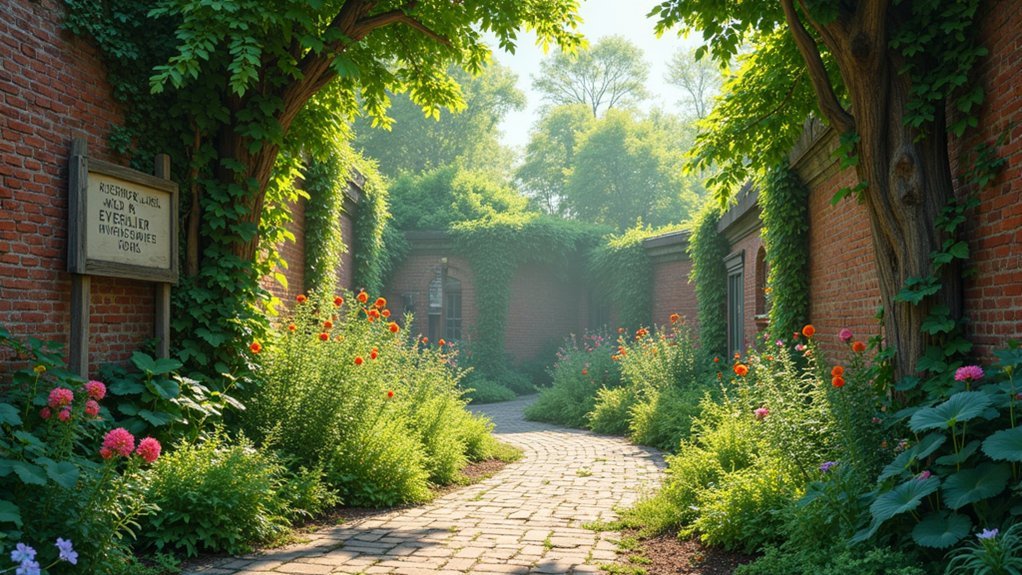Walking your city's wild food garden network connects you with overlooked edible treasures in urban landscapes while fostering community relationships through seasonal harvests. You'll discover sustainable food sources, support local ecosystems, and develop deeper appreciation for urban biodiversity. Creating personal foraging maps helps you identify local hotspots while practicing ethical harvesting techniques. As you explore these hidden networks, you'll transform ordinary neighborhood strolls into meaningful journeys through nature's pantry.
Discovering Edible Treasures in Urban Landscapes

While many city dwellers rush past weeds and overgrown lots without a second glance, these overlooked spaces often harbor an abundance of edible plants waiting to be discovered.
You'll find dandelions, plantago, and fennel thriving even in neglected corners of lower-income neighborhoods, resilient against urban conditions.
Urban foraging connects you directly with sustainable food sources right outside your door. By mapping local resources like fruit-bearing trees with branches extending over public spaces, you'll uncover a network of wild edibles that most people never notice.
This practice isn't just about free food—it's about food justice, creating equitable access to nutritious options regardless of neighborhood wealth.
Local classes can help you identify safe plants to harvest, ensuring you'll forage with confidence and responsibility.
Connecting With Community Through Seasonal Harvests
Seasonal harvests transform urban foraging from an individual pursuit into a community celebration.
When you participate in these gatherings at community gardens, you'll connect with neighbors while collecting fresh, local food that changes with each season.
You'll find these harvests create natural excitement as everyone anticipates new edibles throughout the year. Local chefs often join these events, sharing innovative ways to incorporate foraged ingredients into memorable meals.
Through these seasonal activities, you're not just gathering food—you're building meaningful relationships.
You'll exchange knowledge about nutritional benefits and culinary uses of wild edibles while strengthening social bonds. As you share your harvest with others, you'll contribute to a collective appreciation for local biodiversity and sustainable practices that benefit everyone in your community.
Understanding the Ecological Benefits of Food Garden Networks

Beyond providing fresh food, urban garden networks serve as essential ecological sanctuaries that benefit our entire ecosystem.
As you explore these wild foods havens, you're walking through miniature biodiversity hotspots that support numerous species from insects to birds.
Your participation in urban agriculture directly counters climate change effects through carbon sequestration—plants capture carbon dioxide as they grow, storing it in soil and vegetation.
These networks improve soil health while reducing erosion, completing natural nutrient cycles that industrial farming often disrupts.
When you support gardens that integrate native plants with edibles, you're helping sustain important pollinator populations.
This ecological stewardship connects you to local environmental issues and encourages sustainable practices.
The wild food garden network you traverse isn't just feeding people—it's nurturing the entire web of life in your city.
Mapping Your City's Foraging Hotspots
The ecological knowledge you've gained now becomes practical as you begin to identify specific foraging locations in your urban landscape.
Creating a personal map of foraging hotspots connects you directly with urban food sources often hidden in plain sight. Apps like iNaturalist help document these treasures while building community connections with fellow foragers.
Urban foraging maps transform the cityscape into a personal harvest calendar, revealing nature's abundant pantry amidst concrete.
- Look for common urban edibles like mulberries, figs, and dandelions that thrive in city environments.
- Document seasonal patterns to understand when specific plants will be available throughout the year.
- Join local foraging groups to share knowledge and expand your awareness of neighborhood resources.
Ethical Practices for Sustainable Urban Harvesting

While the abundance of wild foods in urban spaces offers exciting opportunities, responsible foraging requires a commitment to ethical practices that protect both natural resources and community relationships.
Always correctly identify plants before harvesting to avoid toxic species like poison ivy or hemlock. This knowledge forms the foundation of sustainable harvesting in urban food forests.
Remember that Texas law prohibits foraging on private property without permission, so building relationships with landowners is essential.
When you do harvest, take only what you need—over-harvesting disrupts ecosystems and depletes wild plant populations.
Be mindful of potential contaminants in public spaces, avoiding areas treated with pesticides or herbicides.
Frequently Asked Questions
How Do I Identify Potentially Toxic Look-Alike Plants?
You'll need to study field guides, take classes with botanists, and use plant identification apps. Don't eat any plant until you're 100% certain it's safe. Always check multiple identifying features before consuming.
Are Permits Required for Harvesting in Public Food Gardens?
You'll need to check local regulations before harvesting from public food gardens. Many require permits, while others operate on honor systems. Contact your city's parks department or garden coordinator for specific requirements.
What Equipment Should Beginners Bring on Urban Foraging Expeditions?
You'll need a basket, pruning shears, gloves, field guide, water bottle, and small paper bags. Don't forget your phone for identification apps and a map showing public harvesting areas. Wear comfortable shoes!
How Do Seasonal Weather Patterns Affect Wild Food Availability?
Seasonal weather patterns directly impact what you'll find. Spring brings tender shoots, summer offers abundant berries, fall delivers nuts and fruits, while winter limits your finds to hardy evergreens and preserved items.
Can Children Safely Participate in Urban Foraging Activities?
Yes, children can safely participate in urban foraging with proper supervision. You'll need to teach them plant identification, avoid polluted areas, and guarantee they don't eat anything without adult verification first.
In Summary
You're now part of an urban food revolution that's transforming concrete jungles into nourishing landscapes. By walking your city's wild food garden network, you've connected with neighbors, discovered local flavors, and contributed to a more resilient ecosystem. Keep exploring, harvesting responsibly, and sharing your knowledge. Your footsteps are creating pathways to a more sustainable, delicious, and community-centered urban future.





Leave a Reply